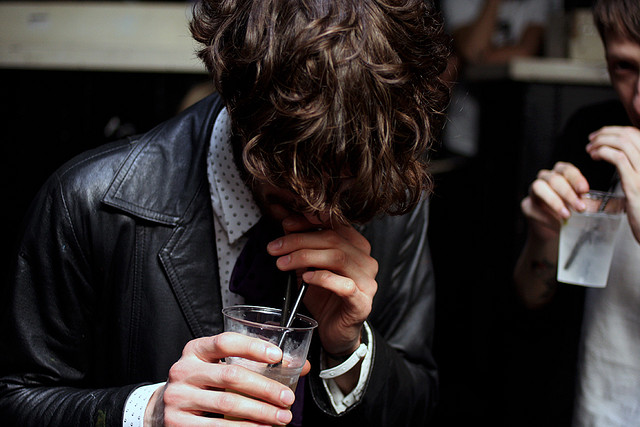One main street, many bars, and a stubborn U.P. problem
I grew up in Negaunee. Its Main Street has a row of bars. A row. There’s no bookstore in the town. No cineplex. But you can ricochet down the street and hit at least five bars. Maybe more.
We come from a drinking culture. And I’m not talking about France’s healthy glass of red wine with your meal. I’m talking about something else. If you’re a fellow Yooper, you’ve probably had drinking destroy somebody in your family – an uncle, an aunt, a cousin, a grandfather.
I remember going to Teen Leadership and Pip Fest when I was in high school – programs set up for teens dealing with drug and alcohol abuse in their families. I remember a hell of a lot of tears. (Such an incredible contrast to those wacky beer commercials.)
I’m saying all this so you understand growing up in the U.P. left me a little haunted by drugs and alcohol. I saw what it did to people I cared about and the sight of the effects was stronger than any Just Say No campaign. What’s interesting is that now, having grown up and become a writer, the demons of booze demonstrate themselves in other ways, i.e. in the stories I’m covering.
For example:
Recently I had the idea of finding out about crime in the U.P., its roots, its causes.
When I talked to Detective Sergeant Tom Swanson of the Sault Ste. Marie Police Department and Patrol Captain Blake Rieboldt of the Marquette PD, I wanted to know what factor keeps popping up as far as U.P. crime. Was it predominantly males? Twenty-somethings? The poor? A particular area?
No, no, no, no.
The great discovery for me was finding out that the one factor that seems to be connected to the majority of crime for the region was also linked to the current health problems facing the U.P.: Alcohol abuse.
When we’re speaking of improving health and lowering crime rates, we mean reduction of drug and alcohol dependency. It’s that simple.
Or that complex.
Andy Chosa, foundation coordinator of Great Lakes Recovery Centers, said, “The crime that does take place in the U.P. is very highly likely to be linked to someone with a substance abuse disorder.”
The most recent crime report for Marquette County – the most populated in the U.P. – shows only two crime categories reached beyond 1,000 occurrences – larceny (1,118 occurrences) and all other, including drunkenness & vagrancy (1,945 occurrences). Chippewa County, the second largest county, had over 1,000 occurrences of disorderly conduct (1,227) and all other, including drunkenness and vagrancy (1,705). Disorderly conduct and larceny are linked to drunkenness and drug use.
“It’s not getting any better,” said Rieboldt.
In fact, when it comes to drugs like methamphetamine, Rieboldt said in the last two years, “meth has hit us like a ton of bricks.”
Swanson said the same is true with heroin. Swanson has found a slow, but steady increase in heroin usage, stating, “heroin is creeping its way into this area. It’s growing.”
One might question if, or why, people in the U.P. seem prone to drug and alcohol abuse – the long winters? The poverty? The lack of sufficient positive alternative choices?
“Everything kind of revolves around beer and wine,” said Rieboldt, adding, “It’s just part of our culture.”
But that culture might be more on the national level rather than just selectively in the U.P.
Chosa puts things in statistical perspective, saying that according to the recent 2011 Michigan Department of Community Health reports, “approximately one in four” U.P. residents is alcohol dependent. “It’s a staggering problem,” said Chosa. Those numbers are in line with the national average, but they are not good statistics by any means.
Chosa quoted a sheriff who stated, “I’ve got people in my jails that aren’t criminals.”
The solution, Chosa said, is rehab.
Rieboldt agreed, saying, “There is some success with rehabilitation.”
“We know what works,” said Chosa, “Sustained, continuous treatment plans.”
Swanson said the public needs to utilize the programs set up in the community to assist with issues of need, such as the Diane Peppler Resource Center and the Advocacy Resource Center for the Sault Ste. Marie Tribe of Chippewa Indians, which work hand-in-hand.
Swanson said there “are so many programs available people don’t know about.”
Chosa said those wishing to donate can go directly to the non-profit Great Lakes Recovery Center web site.
He encouraged those with drug and alcohol problems to get actively involved in stopping their addiction cycle, encouraging them to pick up a phone, go to a doctor, go to A.A., go to rehab, tell a family member.
And for those so tied to their addiction that they cannot break free on their own, Chosa encourages friends and family to make contacts for the person. Before the addiction leads to a life-changing criminal altercation with the police.
See what new members are saying about why they donated to Bridge Michigan:
- “In order for this information to be accurate and unbiased it must be underwritten by its readers, not by special interests.” - Larry S.
- “Not many other media sources report on the topics Bridge does.” - Susan B.
- “Your journalism is outstanding and rare these days.” - Mark S.
If you want to ensure the future of nonpartisan, nonprofit Michigan journalism, please become a member today. You, too, will be asked why you donated and maybe we'll feature your quote next time!


 If you live in the U.P., you likely know someone whose life has been damaged by drugs or alcohol. “It’s part of the culture,” local police say. (Photo by Flickr user Fabio; used under Creative Commons license)
If you live in the U.P., you likely know someone whose life has been damaged by drugs or alcohol. “It’s part of the culture,” local police say. (Photo by Flickr user Fabio; used under Creative Commons license)